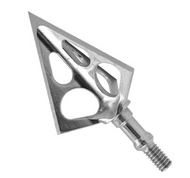Fixed Broadheads Vs. Mechanical
Aug 17th 2023
When it comes to the art of hunting, precision and effectiveness are paramount. The choice between fixed blade and mechanical broadheads can significantly impact the outcome of a deer hunt. Both types of broadheads have their own set of advantages and disadvantages, making the decision a matter of personal preference and hunting strategy.
Are Mechanical Or Fixed Broadheads Better For Deer?
The question of whether mechanical or fixed broadheads are better for deer hunting has been a topic of debate among hunters for years. Mechanical broadheads, also known as expandable broadheads, feature retractable blades that deploy upon impact. On the other hand, fixed blade broadheads have blades that remain stationary from the moment they are released until they strike the target.
Advocates of mechanical broadheads point to their aerodynamic design and reduced wind resistance, which can lead to greater accuracy and flatter trajectory. The expanding blades are also thought to cause larger wound channels, potentially leading to more lethal hits. Additionally, mechanical broadheads are often favored by bowhunters who value their ability to maintain field-tip accuracy due to their streamlined profile.
However, fixed blade broadheads also have their staunch supporters. One of the key advantages of fixed blade broadheads is their inherent reliability. Since the blades are always open, there's no potential for mechanical failure upon impact. This reliability can be crucial, especially when targeting big game like deer, where a malfunctioning broadhead could mean a lost opportunity. Moreover, fixed blade broadheads are generally simpler in design, making them less susceptible to damage from bone or other obstructions.
What Are the Advantages Of Fixed Blade Broadheads?
- Reliability: Fixed blade broadheads are not dependent on mechanical components to function properly, reducing the risk of failure upon impact.
- Penetration: The solid design of fixed blade broadheads can provide better penetration through bone and tough hide, leading to more effective shots.
- Versatility: Fixed blade broadheads can be used with a wider range of draw weights and arrow speeds, making them a more versatile option for various hunting scenarios.
- Cutting Diameter: Some fixed blade broadheads offer a wider cutting diameter, creating larger wound channels and potentially quicker kills.
- Durability: The simpler design of fixed blade broadheads often results in increased durability, allowing them to withstand challenging hunting conditions.
Many hunters are drawn to fixed blade broadheads due to their unwavering reliability, proven ability to penetrate tough targets, adaptability to various equipment setups, capacity to create larger wound channels, and robust construction that can withstand the rigors of demanding hunting conditions.
Are Mechanical Broadheads Worth It?
While mechanical broadheads offer certain advantages, they also come with their own set of considerations. The retractable blades of mechanical broadheads can sometimes fail to deploy as intended, resulting in reduced accuracy and potentially poor shot placement. Furthermore, their complex design can make them more susceptible to damage from external factors like vegetation or bone. These factors can lead some hunters to question whether the potential benefits of mechanical broadheads are truly worth the risk.
Ultimately, the decision to use mechanical broadheads depends on an individual's level of confidence in their equipment, as well as their familiarity with the mechanics of these broadheads. Proper testing and practice are essential when using mechanical broadheads to ensure that they consistently perform as expected in various hunting scenarios.
Which Is More Expensive?
Cost can also be a factor in the choice between fixed blade and mechanical broadheads. Generally, mechanical broadheads tend to be more expensive than their fixed blade counterparts. This price difference can be attributed to the intricate mechanical components required for the expandable blades. However, it's important to note that while fixed blade broadheads may be more affordable, they also require careful sharpening and maintenance to ensure optimal performance.
Conclusion
In the world of deer hunting, the choice between fixed blade and mechanical broadheads boils down to finding what clicks best with you. If you're someone who values tough and sturdy options, fixed blade broadheads might be your go-to. These broadheads are like the dependable workhorses of the hunting world – they're always ready, no matter the conditions. They're known for their ability to pierce through tough hides and bones, ensuring a good hit even in challenging situations.
On the other hand, if you're the type of hunter who seeks pinpoint accuracy, mechanical broadheads might be more up your alley. These broadheads are designed to fly like darts and hit their mark with impressive precision. They open up upon impact, creating larger wound channels that can potentially lead to quicker kills. This precision can be a game-changer, especially when you need to make every shot count.
Whichever option you lean towards – fixed blade or mechanical broadheads – the key is to choose what resonates with your hunting style. Your confidence in your chosen broadheads and your familiarity with their behavior upon impact are essential components of a successful hunt. Ultimately, the preference between fixed blade and mechanical broadheads is a nuanced decision, shaped by factors such as accuracy, reliability, wound potential, and personal comfort.



